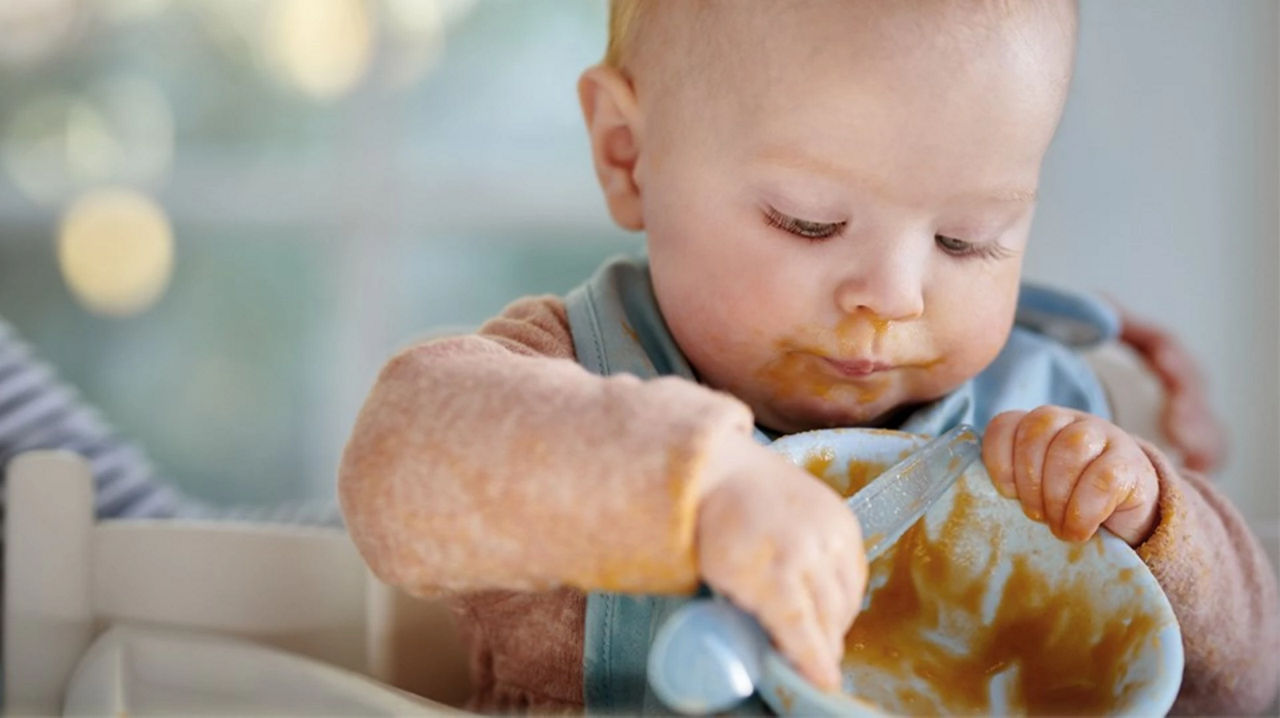Now that your baby’s digestive system is more developed and the natural stores of iron they were born with are running low, it is the perfect time to introduce them to their first foods. A more varied, solid diet – including extra iron – is vital for your 6-month-old baby to support their continuing brain and muscle development.
6 month old baby: Development & nutrition advice
Any old iron?
At 6 months, iron stores start to run low

What’s been happening this month?
Your 6-month-old baby is about to reach a significant development milestone – their first taste of ‘solid’ food. If you are breastfeeding, this may feel like the beginning of a new phase, as your baby starts to rely less on you for their nutrition. However, your breast milk is still a very important part of the diet while solid foods are slowly introduced over the next few weeks and months.
Weaning at six months coincides with the natural depletion of the iron stores your baby was born with. Therefore, it is important to replenish them with an iron-rich weaning diet alongside their usual milk.
Your baby’s developing brain
By six months, your baby will usually be able to roll over from back to front. And, if you hold them while they are standing, they can take weight on their legs1. Now they are sitting up unaided, they may turn their head from side to side, which might seem like a disadvantage when you are trying to manoeuvre a spoon into their mouth!
Your baby might respond to, and imitate, your facial expressions and sounds. As their memory and attention span increase, they’ll begin to pick out components of your speech and hear the way words form sentences. All of this will help their brain grow and develop in preparation for speech.
 At 6 months, your baby will reach some important milestones
At 6 months, your baby will reach some important milestones
At six months, the natural stores of iron your baby was born with start to deplete.
Their strengthening back muscles
Many babies spend their sixth month perfecting the art of sitting up. Between the ages of four and five months, they may be able to sit in a slumped position, but will often topple over1.
As they start to use their arms to prop themselves up, things get easier. And, once their back muscles are strong enough – usually at around six months – they will rely less on their arms for support, and finally be able to sit upright on their own1.
… at around 6 months they will rely less on their arms for support, and finally may be able to sit upright on their own.
Pumping up their iron levels
Iron is especially important for your 6-month-old baby’s brain development. It plays a vital role in the function of the nervous system, enabling nerve cells to transmit information, and brain processes to develop2.
Once weaning has begun, it is important to replenish iron stores with foods that are naturally high in iron, like lean red meat, chicken, eggs, pulses and leafy, green vegetables².
Filling up on iron
To ensure your 6-month-old baby gets enough iron, try to include purées made of foods such as lean red meat, chicken, eggs, peas, beans, lentils and leafy green vegetables in their weaning diet. Once they can manage more complex textures, oily fish such as salmon and sardines, and lightly poached dried fruit like apricots, provide a good source too.
Feeding your 6-month-old iron-rich foods combined with those high in vitamin C can help their body absorb iron more efficiently. Red or green peppers, kiwis, bananas, oranges and strawberries are good sources of vitamin C.
The reference nutrient intake (RNI) for iron is 4.3mg a day for four–six month olds².
Getting more from milk
If you are bottlefeeding, follow-on milk can also provide your 6-month-old with a good source of nutrition. Specially formulated to support a weaning diet, many follow-on milks are fortified with iron to help your baby get the nutrition they need at this stage.
Healthy habits start here
As well as providing an increasing variety of nutrients, your baby’s weaning diet can help to encourage an appetite for, and a willingness to try, a wide range of foods as they grow. Be adventurous and offer lots of different tastes and textures as you move through the weaning stages. It can make the process more fun and interesting for both of you, and you may be surprised by some of your baby’s preferences. Remember though, it can take up to ten tries for a baby to accept a new taste. So if they show signs of not liking a certain food, don’t give up. Offer it several more times – it may even become a favourite.3
Next steps
Add these items to your shopping list:
- Iron-rich foods like lean red meat, green, leafy vegetables, peas and beans.
- Vitamin C-rich foods like tomatoes, kiwis, oranges, bananas and strawberries
- Fortified follow-on milk, if you are bottlefeeding
related articles
Learn more about your baby

Need some help?
You can get quick answers to common questions in our FAQs.
Alternatively, if you need help with general pregnancy or baby advice, or maybe on using or ordering our products - our expert team are always on hand to talk about feeding your baby.
1.Parenting. Month-by-month guide to baby's milestones [Online]. Available at: https://www.parents.com/baby/development/growth/baby-milestones-month/ [Accessed April 2014]
2. Department of Health. Dietary Reference Values for Food Energy and Nutrients for the United Kingdom: Report of the Panel on Dietary Reference Values of the Committee on Medical Aspects of Food Policy [Online]. 1991. Available at: http://books.google.co.uk/books?id=iFkgAQAAIAAJ [Accessed April 2014]
3. Schwartz et al (2011) Development of healthy eating habits early in life: review of recent evidence and selected guidelines. Appetite 57:796-807
Last reviewed: 13th August 2014






